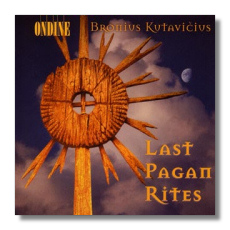
The Internet's Premier Classical Music Source
Related Links
- Latest Reviews
- More Reviews
-
By Composer
-
Collections
DVD & Blu-ray
Books
Concert Reviews
Articles/Interviews
Software
Audio
Search Amazon
Recommended Links
Site News
 CD Review
CD Review
Bronius Kutavičius

Last Pagan Rites
- Last Pagan Rites
- Epitaphium Temporum Pereunti
Leopoldas Digrys, organ
Gintare Skeryte, soprano
Mindaukas Budzinauskas, horn
Linas Dakinevicius, horn
Loranas Gadeikis, horn
Mindaugas Pupeikis, horn
Choir of the Vilnius Čiurlionis Art School/Romualdas Gražinis
Kaunas State Choir
Lithuanian National Symphony Orchestra/Robertas Šervenikas
Ondine ODE972-2 DDD 65:12
We have become aware of the Baltic nations as the source of some astonishing music in the past several years. This CD is another galvanizing example of what used to be hidden behind the Iron Curtain. Bronius Kutavičius, born in 1932, was educated in his native Lithuania. I gather from the absence of information to the contrary in Ondine's booklet notes that Kutavičius has remained a phenomenon exclusive to his country. The notes go further to describe him as a "long-standing cult figure in Lithuanian composition." Whatever he is, his music is almost literally magical.
They also indicate that he is "considered the harbinger of minimalism in Lithuanian music" – the phrases "expressionistic minimalism" and "ritualistic minimalism" also are used. However, the material that he uses is folk-derived, if not literally, than certainly in spirit. The first movement of Last Pagan Rites (1978) strikingly illustrates the composer's brand of minimalism, if that is his preferred description. Short choral phrases are obsessively repeated in different phases by different sections of the choir to create a dense, restless structure. Notes from the organ and four horns drone and mimic cathedral bells. In the next movement, the choir's women freely chant and whisper, and the effect is like overhearing the prayers of the devout in a church or mosque. A soprano soloist sings a simple but – through repetition – incantatory song over this bed of shimmering sound. Kutavičius might have notated these effects precisely – I haven't seen a score – but the chorus is called upon to produce music that sounds as natural and spontaneous as it is unusual. The remaining two movements create similar impressions through similar means. The dominant sound of Last Pagan Rites is that of a choir broken into many voices, each teeming with activity, yet coalescing into a unified whole. Apparently, in performance, the choir moves around the hall and through the audience, an effect unfortunately only distantly recreated on CD.
Epitaphium Temporum Pereunti (1998) is translated as "Epitaph to Passing Time." This "symphony-oratorio" is a sort of mini-history of Lithuania in four movements. The simplicity of Last Pagan Rites has been supplemented with an exuberant unleashing of orchestral sound, brutal at times, and delicate at others. The choral writing remains ritualistic, although it is less dependent on repetition and phasing effects. What does remain is the use of techniques such as choral speaking and "controlled randomness." Imagine Orff's Carmina Burana combined with Penderecki's St. Luke Passion and that will give you a good idea of what Epitaphium sounds like much of the time. I don't find Kutavičius's music to be derivative of either, though.
The performances seem definitive and the engineering is exemplary. No one interested in what I've written so far need hesitate. This CD will appeal to many listeners, even to those who aren't frequent listeners to classical music. The booklet contains an English translation of the text to Epitaphium, but not the original Latin, and no texts or translations for Last Pagan Rites, which is a shame for these unfamiliar works.
Copyright © 2001, Raymond Tuttle




















